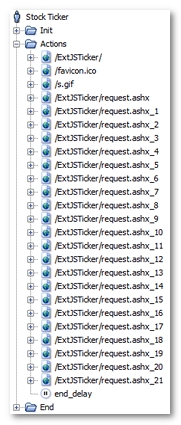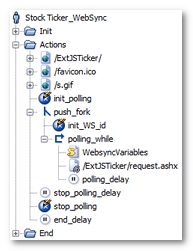WebSync polling
- Warning: At the end of recording, a dynamic parameter search must be launched for NeoLoad to be able to handle the WebSync dynamic session id's (clientId).
After the recording, a User Path using the WebSync Push Framework is displayed as follows.

The following point should be noted:
- A large number of HTTP requests with the format XXX/request.ashx have been recorded. These requests are polling requests.
Once processed by the Post-recording wizard, the User Path is modified as follows.

NeoLoad has made the following noticeable changes:
- All WebSync polling requests have been grouped into a single polling request (/request.ashx for example). This request has been placed in a loop (polling_while for example), which continues to loop until the NL-stopPolling variable generated by NeoLoad becomes true. Lastly, the loop itself has been placed in a secondary execution thread using a fork action (push_fork for example). See Polling requests.
- The variable modifier init_polling initializes the NL-stopPolling variable, with the false value, to have the polling function work on every Virtual User iteration.
- The WebSync id parameter is handled using a JavaScript action (WebsyncVariables for example). At the first polling loop, the initial value is calculated in relation to the request that precedes the polling; it is then increment at each loop iteration to reproduce the browser behavior.
- The variable modifier init_WS_id resets the WS_id variable to make the WebSync parameter consistent on every Virtual User iteration.
- The polling_delay polling delay is the average of the time intervals between two polling requests in the original User Path.
- The stop_polling variable modifier stops the polling loop by modifying the value of the NL-stopPolling variable.